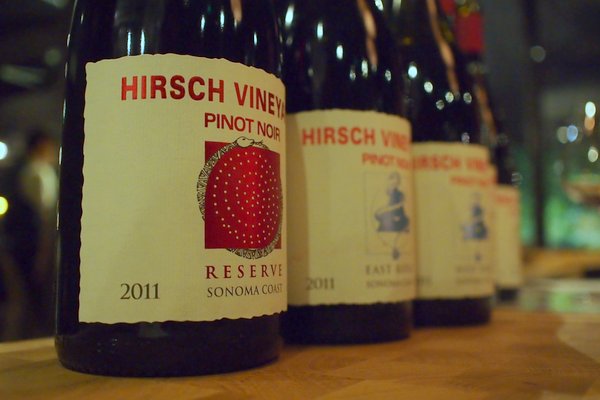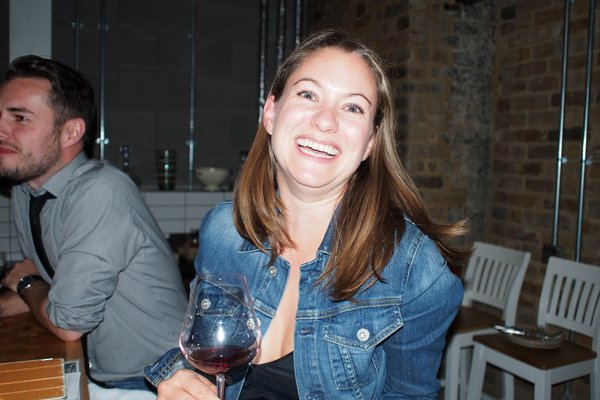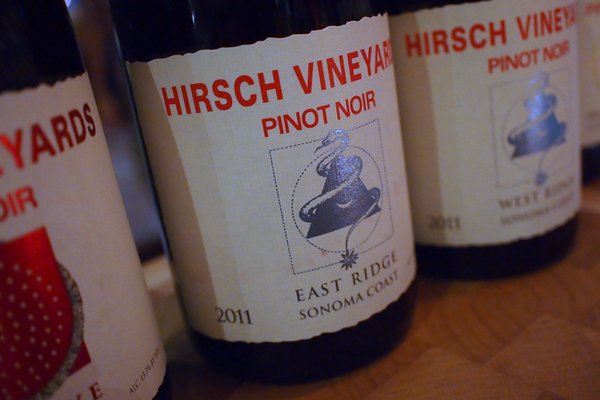|
The
wines of Hirsch Vineyards
Remarkable Pinot Noirs from California's Sonoma Coast
With Jasmine Hirsch at The Grain
Store, London, August 2013
Website: www.hirschvineyards.com

Jasmine Hirsch, daughter of Hirsch
Vineyards proprietor David Hirsch, was in town, visiting her new
importers Roberson Wine (www.robersonwine.com).
So Roberson's Mark Andrew asked me if I’d like to come out to
play. Of course!
California is making some serious Pinot
Noir these days, and Hirsch is one of the stars. But it started out
almost by accident.
Let's backtrack to the 1970s. David
Hirsch, from an immigrant family in the Bronx, went to Colombia
University but dropped out after a year. So he went to California to
become a hippy. He then got into the fashion business (selling women's
clothing), which took him to Paris on regular business trips. From
Paris he found his way to Burgundy and got bitten by the wine bug.

Jasmine Hirsch
Living in Santa Cruz, he’d had the
premonition that California would one day get crowded, so he decided
to buy some land while it was still available. He looked around and
found a huge sheep ranch, about the same distance north of San
Francisco as Santa Cruz was south. No one wanted to be there: it
used to be redwood forests but it had been completely logged, so
nothing was left. This was a large 400 hectare property, and it
didn’t cost him much.
He’d never intended to plant grapes
here, until he was persuaded to have a go by a friend. In 1980 he
planted 2 acres of Riesling and 1 of Pinot Noir. It was a crazy
place to grow grapes with the ocean just a couple of miles away. He
was a true pioneer of California’s Sonoma Coast.
He carried on working in the clothing
business and sold the grapes to others. Things really started to
move in the early 1990s. This is when Hirsch planted another 40
acres of vines, and began selling to the likes of Williams Selyem,
Kistler and Littorai, all of whom used the ‘Hirsch’ vineyard
designation on their bottles. 30 different wineries have bought
Hirsch grapes, including Rochioli, Siduri and Flowers, in addition
to those already mentioned. The success of the farm meant that David
quit the day job and devoted his energies to growing grapes.
It wasn’t until 2002 that David decided
that Hirsch would make their own wines, and he began with Pinot
Noir. Chardonnay followed in 2006. A winery was built right in the
middle of the vineyard, but this necessitated constructing a 10 mile
power line to connect it up to the grid. It’s quite a remote
place.
There are currently 68 acres of vines,
with plantings taking place in three stages: 1980, early 1990s and
another 20 in 2012/3. Hirsch is a single vineyard, but within the
vineyard there’s a lot of complexity. ‘It’s like a village in
Burgundy,’ says Jasmine. ‘There are 40 parcels in 68 acres.’
These parcels are all vinified separately. The soil complexity stems
from the fact that this site is half a mile from the San Andreas
fault, where the north American plate meets the Pacific plate. It
leads to a mix of soil types and a detailed topography of hillsides
that can lead to widely differing microclimates on the property,
with a 15 F difference across the site on a single day.
A big change has recently occurred in the
viticulture. Ted Lemon of Littorai persuaded David to farm Block 6
organically for him (Littorai is biodynamic). David loved the
results, seeing slowed fruit maturity, raised health and lowered
vigour. He is now in the process of converting all of Hirsch to
biodynamics. 60% of the vineyard is now managed biodynamically, with
the remaining 40% receiving compost. David says that the full
conversion will take 50 years. ‘He’ll be 69 next week,’ says
Jasmine. ‘He’s a workaholic.’ Andrew Lorand is helping with
the move to biodynamics as a consultant.
What makes these wines special is the way
they combine concentration with balance. There’s an elegance to
them, and no trace of over-ripeness. 2008 was, says Jasmine, a real
wake up call. This was when Chardonnay came in at around 15% alcohol
and Pinot Noir at 14.5%. Now the alcohol levels are around 13% and
the wines show no sign of under-ripeness.
In 2010 new winemaker Ross Cobb joined
Hirsch. Ross has his own label, Cobb, and is highly regarded.
‘Finally we have a winemaker who is equal to my father,’ says
Jasmine, clearly delighted that her dad’s viticultural skills are
being matched by the work done in the winery.

THE
WINES
Hirsch Vineyards San Andreas Fault
Pinot Noir 2010 Sonoma Coast, California
From 30 different blocks, this is a macro expression of Hirsch.
Fresh with nice structure. Lovely complex black cherry and plum
fruit, showing some richness and depth but also real freshness with
a savoury, mineral twist and lovely balance. Dense but not at all
jammy, with good acidity. 94/100
Hirsch Vineyards san Andreas Fault
Pinot Noir 2011 Sonoma Coast, California
Immediately, this seems elegant and inviting. Sweet cherry and
plum fruit with a supple personality and nice freshness. Poised with
silky texture to the smooth cherry fruit. Some mineral characters,
too: lovely stuff. 94/100
Hirsch Vineyards West Ridge Pinot Noir
2011 Sonoma Coast, California
Supple, expressive and really elegant with lovely silky cherry
fruit. Perfumed and fresh, showing great acidity and subtle green
herby notes. Amazing freshness, purity and elegance. 96/100
Hirsch Vineyards East Ridge Pinot Noir
2011 Sonoma Coast, California
This is quite a rich expression of Pinot Noir, showing spicy,
dense, sweet berry fruits. Supple and smooth with freshness as well
as ripeness. Quite a bit of structure, too. 94/100
Hirsch Vineyards Reserve Pinot Noir
2011 Sonoma Coast, California
Powerful but still fresh with good structure alongside the sweet
cherry and plum fruit. Lovely density. Supple with good
concentration, retaining elegance despite the intensity. Lovely
structure and weight. 96/100
See
also:
 The
wines of Littorai The
wines of Littorai
 The
wines of Kutch The
wines of Kutch
Wines
tasted 08/13
Find these wines with wine-searcher.com
Back
to top
|

